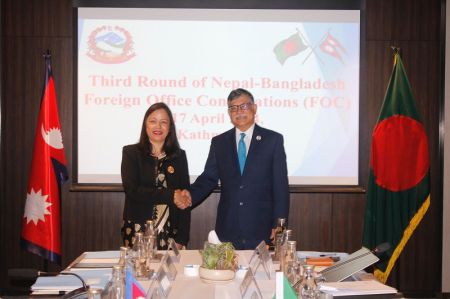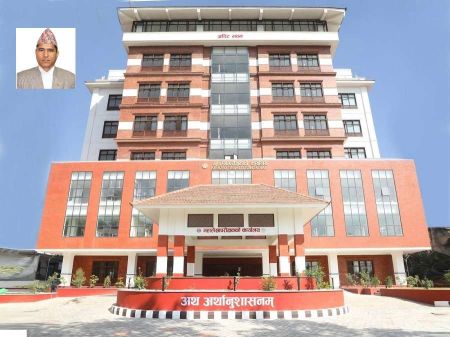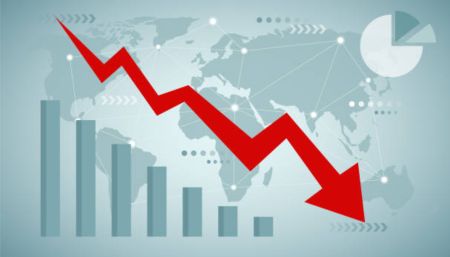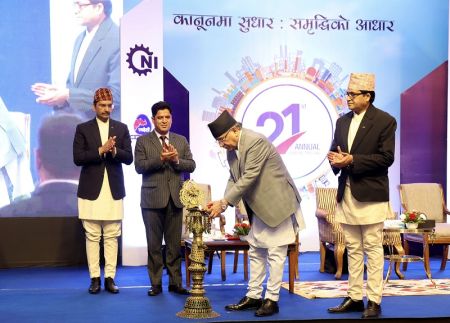--By Akhilesh Tripathi
‘Nepal does have natural resources. They are of course our growth potentials but not necessarily the key element needed for our future economic growth. The key element is human resource; the brainpower, creativity of the people, entrepreneurship and innovation. If we can unlock our human potential, if we can unlock entrepreneurship and innovation which will make use of the natural resources that Nepal has, then our growth potential will be unlocked; we will become a rich country.”
Thus spoke Finance Minister Dr Ram Sharan Mahat, the chief guest of the second edition of the Asian Paints NewBiz Business Conclave & Awards, organized by New Business Age Pvt Ltd at Hotel Soaltee Crowne Plaza on September 11.
.jpg)
.JPG) Investing in Human Resource
Investing in Human ResourceThe remarks of Dr Mahat, a six-time finance minister, are a clear departure from the traditional belief that natural resources are a must for the economic growth of any country. The appropriate use of the available natural resources is necessary, the Finance Minister said, adding, however, that the country’s economic development is possible through the use of brainpower, creativity, entrepreneurship and innovation. He cited examples of Japan, Hong Kong, Taiwan and South Korea which have achieved fast economic growth despite having practically very little natural resource.
Deependra Bahadur Kshetry, former vice-chairman of the National Planning Commission (NPC), who too attended the Conclave, agrees with the finance minister. “We need more skilled and trained human resource, creativity and innovation in business and entrepreneurship to exploit our abundant natural resource, which gives us a comparative advantage. However, the endowment of natural resource alone is not enough. This is what the finance minister means. And this is true as well,” said Kshetry, while talking to New Business Age after the conclusion of the Conclave.
Kshetry says the government should invest more in developing the country’s human resources because it will help build the national capacity. “In simpler terms, it means investing more in education and skill-oriented training. Investment in human resource will help unlock our growth prospects,” he added.
To invest in human resource development is to compete with investment in infrastructure and other social sectors. Here, the government has harder choices to make as it cannot choose one sector over the other as almost all sectors in Nepal need investment, and huge ones, for the matter. So, according to economists and development experts, the government will do well to have a well-designed national development plan, which will clearly spell out our national priorities. “It will help attract international support as well. Then it will be easier for the government to decide in which areas to use domestic resources and in which areas external resources,” say Kshetri.
Managing Director of Jade Consult, Bkesh Pradhanga, another speaker of the Conclave, echoed similar sentiments. “The government should mobilize our human resource properly. For this, the government should invest in higher education of the country’s workforce and this should be the primary focus,” he opined.
.JPG) Focus on Three ‘I’s
Focus on Three ‘I’sOur development priorities should not miss the three ‘I’s – infrastructure, investment and inclusion – according to Johannes Zutt, World Bank country director for Nepal and Bangladesh. Zutt, who was also one of the speakers of the Conclave, clearly said that the three ‘I’s should be Nepal’s top priority for now if the country is to achieve fast economic growth.
On the investment front, the level of foreign investment has been low. According to the Investment Board, the total amount of foreign investment in 2012 which was declared the Investment Year was USD 62 million. It went up in 2013 to USD 208 million. In 2014 so far, it is USD 130 million. Domestic investment, too, hasn’t been growing at the expected rate. “Nepal is investing below the rate of investment needed to achieve a double digit growth. There is actually money available in Nepal for higher investment, but it isn’t happening. The business community complains about access to finance, regulatory burdens and labour costs. These are the problems existent is South Asia but it is debilitating in Nepal,” observed Zutt.
But why has large scale investment not come to Nepal? Pradhananga answers, “It is because of political instability, lack of policy predictability, and industrial disputes that have caused the closure of companies like Surya Nepal in the recent past.” He added that Nepal immediately needs an investment of USD 15 billion for various projects that are ready for implementation.
“For private investment to come, we need to create more enabling environment. This is why we have initiated some new incentives to lure private investment from this year’s budget, Dr Mahat said, “In the hydropower sector, for example, we have announced income tax exemption for the next ten years and fifty percent tax rebate for another five years.”
Zutt opined that Nepal is caught in a vicious cycle of investment and infrastructure. “Nepal doesn’t have high enough levels of investment in infrastructure that is necessary for businesses to succeed and because it doesn’t have that infrastructure, it is not getting the investment,” he said.
Pradhananga suggested to the government to focus on infrastructure development for the next one decade. He also advised to change old laws and policies and introduce new ones to attract private investment. “The Hydropower Policy 2001 and Foreign Investment and Technology Transfer Act 1992, to give a few examples, are quite old. The aim of these laws and policies is to attract FDI in the country. But we haven’t been able to make them timely and updated. This has negatively affected our development efforts,” said Pradhananga.
Hydro Hopes
All the speakers of the Conclave agreed that hydropower has great potential in Nepal. “We are rich in water resource. We have huge hydropower potential. We can be the power house of clean energy in South Asia,” said Dr Mahat.
But the reality is different from the rhetoric. Nepal has hardly tapped one percent of its total hydropower potential. So far, the country has been able to produce only about 750 MW of hydroelectricity though the total hydropower potential of the country is said to be over 80,000 MW. That means one of the sectors where Nepal’s growth prospects lie is the hydropower sector. Over half a dozen projects that are together expected to produce more than 5,000 MW of hydroelectricity are in advanced stage of development (see box). The government’s claim to do away with load-shedding over the next three-four years is based on these projects.
“In Nepal, hydropower is one such sector of investment which can bring about a positive change in the entire econom
“If the PDA [project development agreement] with the Upper Karnali hydropower project is signed over the next few days or weeks, then it will be a game changer. It will lead to the signing of PDA with half a dozen other major hydropower projects,” said Dr Mahat.
.JPG) Nepal’s Strategic Location
Nepal’s Strategic LocationThe speakers of the Conclave also said that Nepal’s geographic location between China and India, two rapidly growing economies of the world, provides the Himalayan nation a great opportunity for economic growth. “Nepal’s growth prospects also lie in the fact that it is located between China and India, two of the fastest growing economies of the world. If Nepal can establish itself a trading partner between China and India, it will greatly help Nepal’s economic growth,” said Zutt.
It is worth mentioning here that the annual trade volume between India and China has already crossed USD 70 billion and the two countries have planned to increase it to USD 100 billion by 2015. If Nepal can build roads, highways and rail links to connect its northern border with southern border, then it can effectively work as a trading partner between the two Asian giants, according to economists and development experts.
‘2015: Nepal’s critical juncture’
Addressing the Conclave, Dr Swarnim Wagle, member of National Planning Commission said that the year 2015 will be very crucial for Nepal as the country’s new constitution is expected to be promulgated in 2015. Once, the constitution is ready, Dr Wagle said, Nepal’s political transition would be complete and then the country’s economy can take off. “We are few centuries behind other countries but I think that we can really make the year 2015 our critical juncture and really expedite our path into modernity,” said Wagle.






















